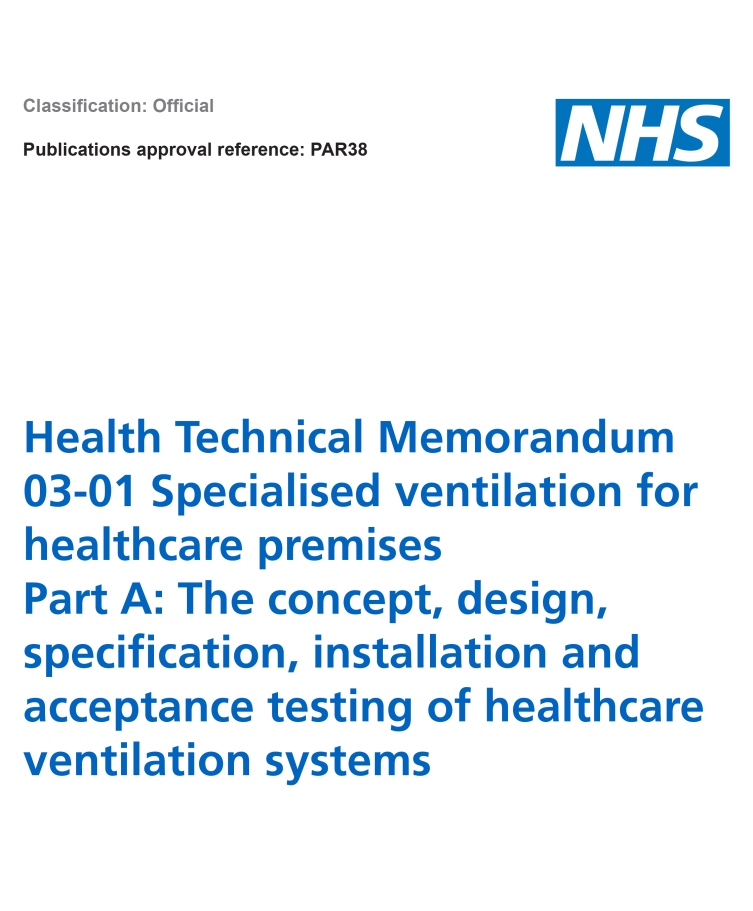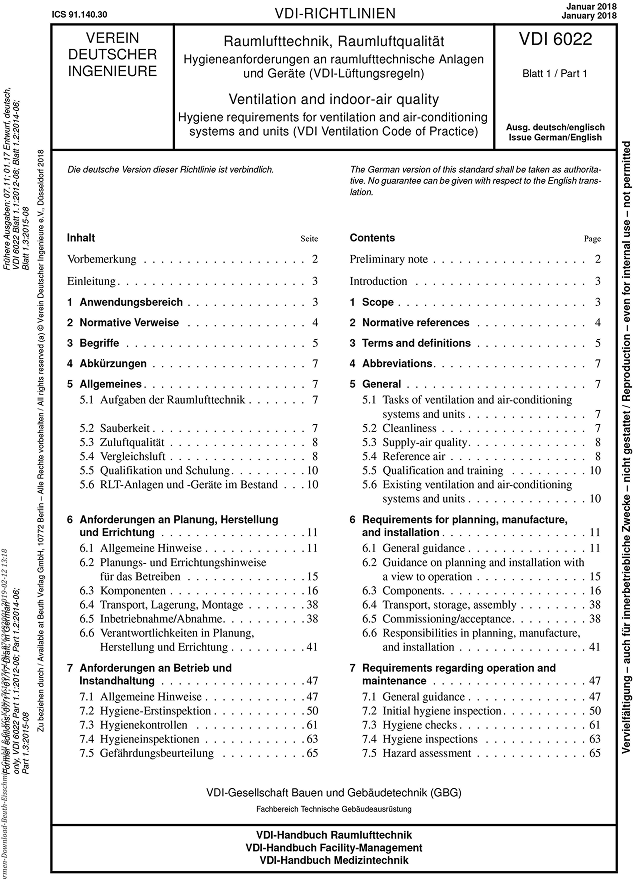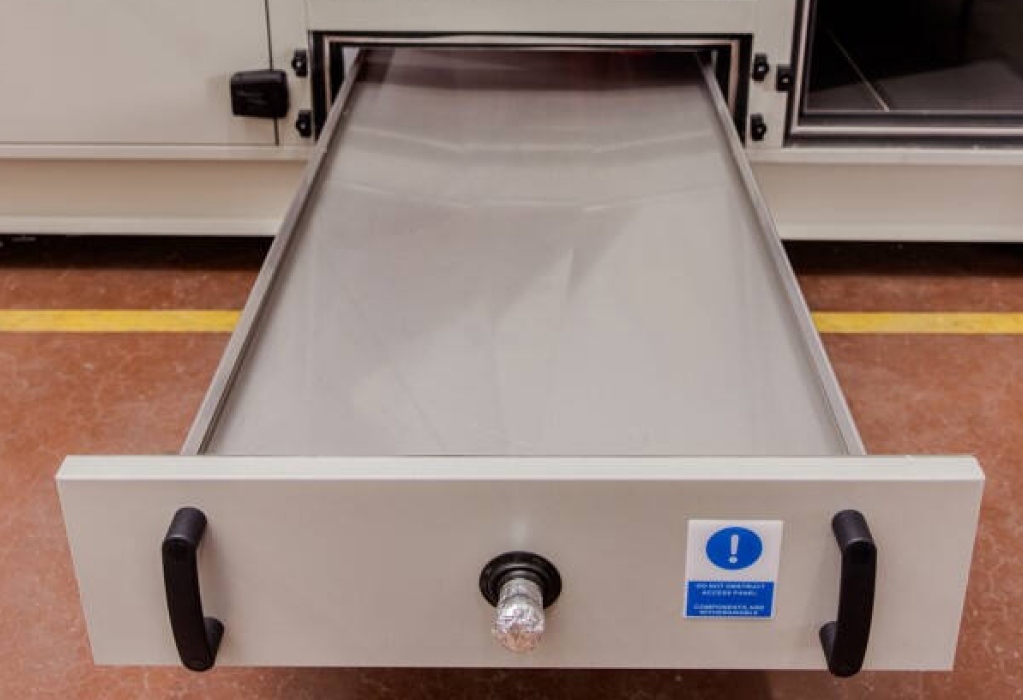Air Handling Units in Healthcare Settings
For expertly carried out FATs, call 01634 729 690.
Comparing HTM 03-01 with VDI 6022: Air Handling Units in Healthcare Settings
In healthcare environments, maintaining high standards of indoor air quality is crucial to safeguard patients, staff, and visitors. A fundamental component of achieving this is the use of air handling units (AHUs), which regulate ventilation, temperature, and humidity, thereby contributing to infection control. This article compares the HTM 03-01 Air Handling Units, the NHS ventilation compliance standard, with the VDI 6022 Guidelines, the German code of practice from the Association of German Engineers (VDI). Both documents define crucial requirements for high hygiene air handling regulations, yet differ significantly in focus, scope, and applicability within healthcare ventilation standards.

Understanding VDI 6022 and HTM 03-01 Standards
VDI 6022 is a guideline developed by the Association of German Engineers that outlines hygiene requirements for ventilation and air conditioning systems in residential, commercial, and industrial settings. Although not designed exclusively for healthcare, VDI 6022 aims to ensure that ventilation systems maintain high indoor air quality, thereby preventing the spread of contaminants that could compromise health, a factor particularly critical in healthcare environments.
On the other hand, HTM 03-01, published by NHS England, is a comprehensive standard explicitly created for healthcare premises. It details the design, specification, installation, and testing requirements for ventilation systems in hospitals and clinical areas. The guidance places a strong emphasis on infection control, sterile ventilation systems, and robust performance criteria tailored to NHS facilities. This ensures that systems support patient safety, reduce infection risks, and meet stringent regulatory standards.
Both standards aim to safeguard air quality, but HTM 03-01 offers a healthcare-specific framework that addresses the complex demands of hospital environments.
Comparing HTM 03-01 and VDI 6022:
Key Considerations for Air
Handling Units
HTM 03-01 and VDI 6022 are both well-recognised standards aimed at supporting safe indoor air quality through effective air handling unit (AHU) design, operation, and maintenance. While both address hygiene and air quality, their intent, scope, and level of specificity vary, particularly when applied to healthcare settings. Below, we explore key points of comparison to support informed decision-making.
1. Focus and Intent
VDI 6022: The guideline provides a broader framework for the hygiene of ventilation systems, including a detailed approach to the design, operation, and maintenance of air handling units (AHUs). It intends to prevent the growth and spread of microorganisms within HVAC systems, ensuring that indoor air quality in healthcare and other settings meets acceptable standards.
HTM 03-01: This document places a strong emphasis on infection control and air quality in hospitals, supporting compliance with clinical ventilation. The specifications for HTM 03-01 air handling units focus on functionality, including filtering methods, airflow rates, and system redundancy, to minimise cross-contamination risks and maintain sterile ventilation systems.
2. Standards and Compliance
VDI 6022: The VDI 6022 guidelines recommend periodic inspections and maintenance, as well as establishing cleaning procedures and moisture control strategies within air handling units (AHUs). Although comprehensive, compliance with VDI 6022 is not mandatory in the same way as NHS HTM ventilation compliance, which is legally enforceable.
HTM 03-01: Compliance with healthcare ventilation standards is obligatory for NHS organisations. The document sets clear hospital air handling regulations, defining requirements for design, filtration, and operation, with compliance checks vital for meeting healthcare facility regulations.
3. Technical Specifications
VDI 6022: The guideline provides comprehensive technical specifications for the design and operation of ventilation systems, including air handling units (AHUs). It provides detailed recommendations for filter types, air change rates, and system configurations. Still, it can be seen as more adaptable to varying applications, making it suitable for use beyond healthcare, in line with UK HVAC filter standards.
HTM 03-01: The HTM focuses on stringent specifications tailored to healthcare settings. It outlines specific air quality parameters, including particulate levels, temperature, humidity, and the requirement for specific types of front-loading filters that are critical in clinical ventilation compliance. It also highlights the need for redundancy in critical systems to ensure that indoor air quality in healthcare facilities is maintained without interruption.
4. Hygiene and Maintenance Protocols
VDI 6022: It emphasises ongoing maintenance and provides guidelines on cleaning and inspection frequencies, aiming for a systematic approach to hygiene that can be applied broadly across different sectors.
HTM 03-01: This guideline outlines detailed maintenance guidelines for healthcare air handling units (AHUs). It requires regular risk assessments, thorough cleaning schedules, and documentation processes specifically related to infection control to support NHS HTM ventilation compliance.
5. Flexibility vs. Specificity
VDI 6022: The more flexible nature of VDI 6022 enables applications beyond healthcare, making it versatile for various types of buildings and industries. Its recommendations can serve as a framework for maintaining hygiene in HVAC systems across various contexts.
HTM 03-01: In contrast, HTM 03-01’s specificity makes it irreplaceable in healthcare environments, as it addresses unique challenges and requirements that are only found in such settings. While it may be less adaptable to non-healthcare applications, its rigour ensures that the highest standards of hygiene and air quality are met in compliance with hospital air handling regulations.
HTM03:01 Clauses where VDI: 6022 falls short of full Compliance (Non Exhaustive List)
When selecting air handling units (AHUs) based on VDI 6022 standards for healthcare applications in the UK, specific additional requirements from HTM 03-01 Part A: Design and Validation must be applied to ensure compliance with NHS healthcare ventilation standards. The list below highlights some key derogations and their associated HTM 03-01 clauses.

Chapter 3.0 Filter Standards and Classifications
- Filter stage specification
SVHSoc.02-V1.2 guidance reflects BS EN 16798-3:2017 (which replaces BS EN 13779:2007), defining recommended final filter stages based on the correlation between outdoor air quality and the required indoor air quality. - Filter test standard update
SVHSoc.02-V1.2 aligns with BS EN 16890:2016 (superseding BS EN 779:2012), guiding the determination of outside air quality, selection of the supply air category, and choice of filter classification.
Chapter 9 Plant and Construction Requirements
- Table 8 (HTM 03-01)
No projecting spires or tech screws inside air handling units (AHUs).
AHU casings to have double metal or composite skins with sandwiched insulation, achieving a Euroclass A fire rating.
Chapter 9 Installation and Maintenance Access
- 9.7
Outdoor AHUs must be fully weatherproof to IP65, secured from unauthorised access, and provide sheltered conditions equivalent to a plant room if grouped. - 9.8
Areas around the plant must be tanked and adequately drained to prevent water penetration during cleaning or maintenance. - Plantroom provisions
- A sink for cleaning glass drainage traps.
- Domestic hot water (DHW) supply with a valved hose connection for internal washing of air handling units (AHUs).
- Lift access for rooftop plantrooms.
Chapter 9 Access and Servicing
- 9.20
- Hinged doors required for routine service elements (filters, fans, heat-transfer devices):
- Minimum 500 mm wide where AHU height >1 m
- Minimum 600 mm wide for smaller units
- Infrequent-access items (e.g., attenuators) are accessible via removable panels with lifting handles or access hatches.
- 9.29
Double-stacked supply/extract units should position fans on the bottom deck for safer replacement and maintenance. - 9.35
The discharge should ideally be located on a different building face than the supply intake, with a minimum separation of at least 4m, and the discharge should be at a higher level.
Chapter 9 AHU Design Preferences
- 9.45
Belt- and pulley-driven fans should not be used in healthcare ventilation systems. - 9.51
Filters must be securely mounted to prevent air bypass, with vertical supports and seals. Frames that allow front withdrawal are required. - 9.56
Compact filters are preferred over floppy bag filters due to the risks associated with orientation and handling. - 9.89 / 9.106 / 9.107 / 9.108
Drip-trays:- Corrosion-resistant (preferably stainless steel)
- Fully draining (1 in 20 slopes; no up-stand at the outlet)
- Baffles to prevent air bypass of coils
- Accessible for cleaning or easily removable without tools where necessary
- 9.116
Attenuator membranes that prevent moisture and dirt absorption and fibre release, with a declared service life of at least 25 years and cleaning access at both ends.
The list of derogations above gives a small percentage of what VDI 6022 non-compliant air handling units require to meet UK healthcare standards as defined in HTM 03-01.

Conclusion
Both VDI 6022 and HTM 03-01 serve significant roles in promoting safe indoor air quality. While VDI 6022 offers broad hygiene guidelines applicable across various industries, HTM 03-01 provides stringent, healthcare-specific requirements essential for patient safety and infection control.
Ultimately, when using HTM 03-01 as a guiding document for air handling units in healthcare settings you should consider the regulatory landscape, the facility’s specific needs, and the overarching objective of ensuring optimal indoor air quality in clinical environments.
As manufacturers of Air Handling Units that can comply with both specifications our advice would always be to use AHUs in Healthcare settings that confirm compliance with HTM03:01 and not VDI 6022. VDI 6022 is better placed in food hygiene application not Healthcare.
See how we put this into practice with
St Georges Hospital
Contact our team today
Get straight through to one of our engineers and start discussing the needs of your new air handling unit. Our team are on hand to work out a custom solution for you and your project. Just call 01634 729 690 or send us an email at sales@eceuk.com to get started.
